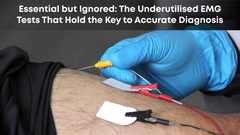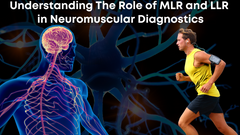Navigating Multifocal Atrial Tachycardia: Symptoms, Causes, Prevention and Treatment
Multifocal Atrial Tachycardia (MAT) is a unique cardiac arrhythmia characterized by a rapid and irregular heart rate originating from multiple atrial foci within the heart. This condition poses challenges in both diagnosis and management due to its distinctive nature.
What is Multifocal Atrial Tachycardia?
Multifocal Atrial Tachycardia is a cardiac arrhythmia characterized by a rapid heartbeat originating from multiple sites in the atria, the upper chambers of the heart. Unlike normal atrial rhythms, MAT involves three or more distinct P-wave morphologies, reflecting the diverse origin of electrical impulses within the atria. This results in an irregular and accelerated heart rate, typically exceeding 100 beats per minute.
Symptoms of Multifocal Atrial Tachycardia:
- > Palpitations: A noticeable sensation of rapid, irregular, or fluttering heartbeats.
- > Fatigue: Due to the heart working harder than normal, patients may experience persistent tiredness.
- > Shortness of Breath: Impaired cardiac function can lead to difficulty in breathing, especially during physical exertion.
- > Chest Discomfort: Some individuals may experience chest pain or discomfort.
- > Dizziness or Light-headedness: Insufficient blood flow to the brain may cause dizziness or light-headedness.
- > Fainting (Syncope): In severe cases, MAT can lead to fainting episodes.
It's essential to note that the severity and manifestation of symptoms can vary among individuals, and some may remain asymptomatic.
What Causes Multifocal Atrial Tachycardia?
Multifocal Atrial Tachycardia often occurs in individuals with underlying heart or lung conditions, and several factors may contribute to its development:
- > Chronic Lung Disease: MAT is commonly associated with chronic obstructive pulmonary disease (COPD) and other chronic lung disorders.
- > Age: MAT is more prevalent in older adults, particularly those with existing cardiovascular issues.
- > Electrolyte Imbalances: Abnormal levels of potassium, magnesium, or calcium in the blood can trigger MAT.
- > Heart Disease: Conditions such as coronary artery disease or heart failure can create an environment conducive to MAT.
- > Medications: Some medications, especially those that affect the conduction system of the heart, may contribute to the development of MAT.
Prevention
While it may not be possible to prevent MAT entirely, especially in cases where it is a secondary manifestation of an underlying condition, certain measures can help minimize the risk and manage the condition effectively:
- > Manage Underlying Conditions: Treating and managing chronic lung diseases, heart conditions, and other underlying issues can help prevent the onset or exacerbation of MAT.
- > Regular Check-ups: Routine medical check-ups are crucial, especially for individuals at higher risk due to age or pre-existing health conditions.
- > Medication Management: Careful monitoring and adjustment of medications, particularly those affecting heart rhythm, can minimize the risk of MAT.
- > Lifestyle Modifications: Adopting a heart-healthy lifestyle, including a balanced diet, regular exercise, and stress management, can contribute to overall cardiovascular health.
Treatment
The approach to treating Multifocal Atrial Tachycardia involves addressing the underlying causes and managing symptoms. Treatment options may include:
- > Managing Underlying Conditions: Treating and controlling conditions such as COPD, heart failure, or electrolyte imbalances is essential for managing MAT.
- > Medications: Antiarrhythmic medications may be prescribed to help regulate the heart rate and rhythm.
- > Oxygen Therapy: In cases where MAT is associated with respiratory conditions, supplemental oxygen may be beneficial.
- > Electrical Cardioversion: In certain situations, a controlled electric shock may be administered to restore normal heart rhythm.
Diagnosing through ECG:
Diagnosing Multifocal Atrial Tachycardia typically involves the use of an Electrocardiogram (ECG or EKG). The distinctive features observed on an ECG include:
- > Irregular Rhythm: MAT is characterized by an irregular heart rate due to the multiple atrial foci firing at different rates.
- > Multiple P-Wave Morphologies: The presence of three or more distinct P-wave shapes reflects the diverse origin of electrical impulses within the atria.
- > Rapid Heart Rate: A heart rate exceeding 100 beats per minute is a common feature of MAT.
Clarity Medical ECG in Detecting Multifocal Atrial Tachycardia:
Clarity Medical's advance and portable ECG devices enhances the precision and efficiency of diagnosing Multifocal Atrial Tachycardia.
- > High-Quality Signal Acquisition: Clarity Medical ECG ensures high-quality signal acquisition, allowing for accurate detection of irregularities in heart rhythm.
- > Simultaneous Multi-lead Recording: Multifocal Atrial Tachycardia can manifest differently in various leads. Clarity Medical's ECG records multiple leads simultaneously, providing a comprehensive view of the heart's electrical activity.
- > User-Friendly Interface: Clarity Medical's ECG devices feature an intuitive and user-friendly interface, streamlining the process of ECG recording and interpretation.
- > Data Storage and Analysis: The ECG recordings can be stored and analyzed over time, facilitating a thorough assessment of the dynamic nature of MAT.
Conclusion:
Multifocal Atrial Tachycardia poses a distinctive challenge in the realm of cardiac arrhythmias, necessitating a comprehensive understanding of its characteristics, symptoms, and treatment options. With advancements in diagnostic technologies, such as Clarity Medical's ECG, healthcare professionals can achieve more accurate and timely diagnoses, leading to improved outcomes for individuals affected by MAT.












